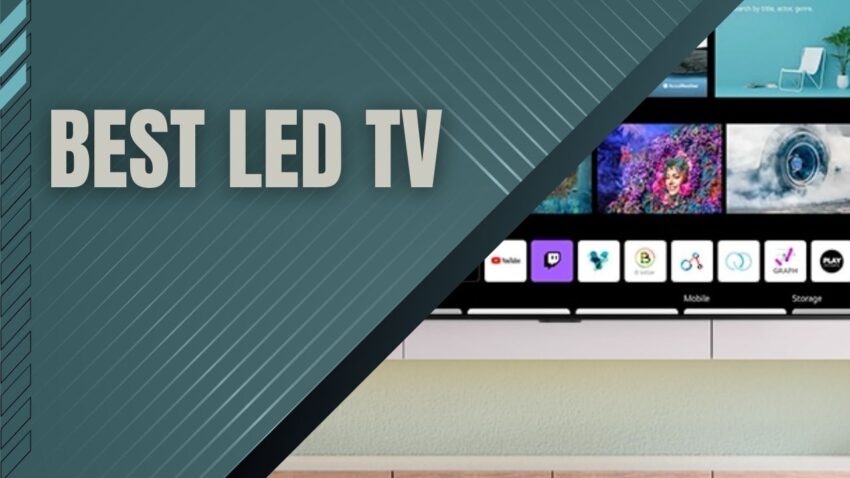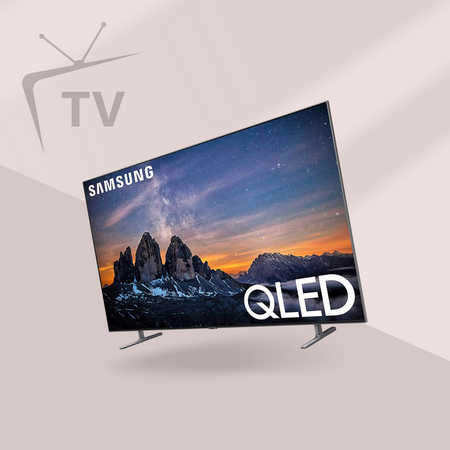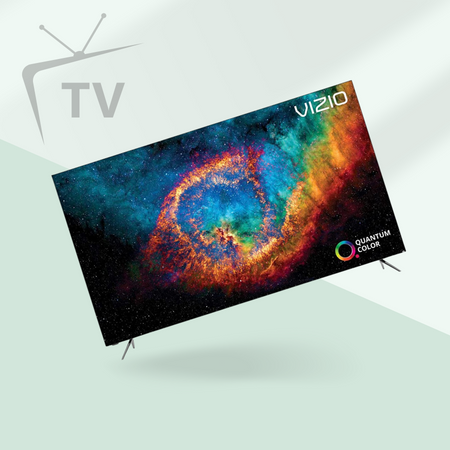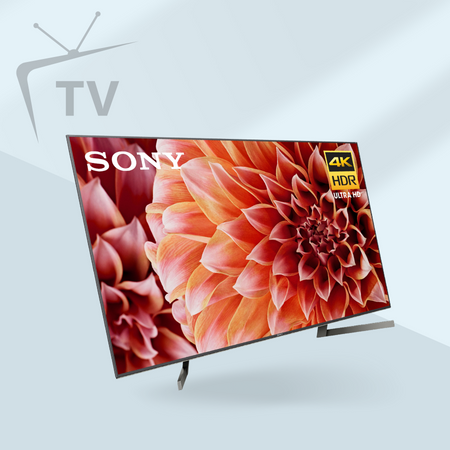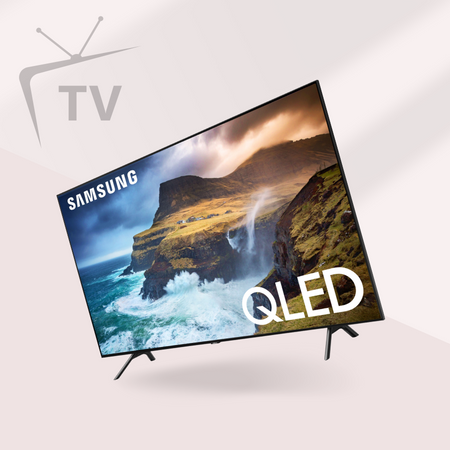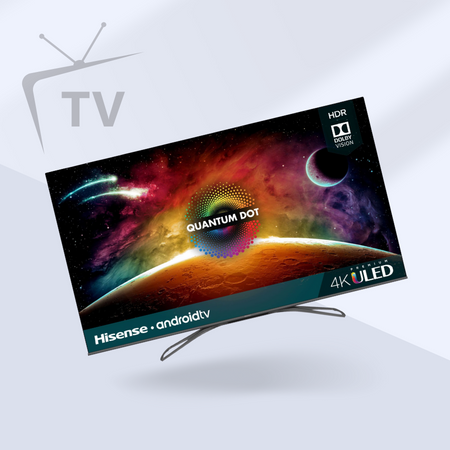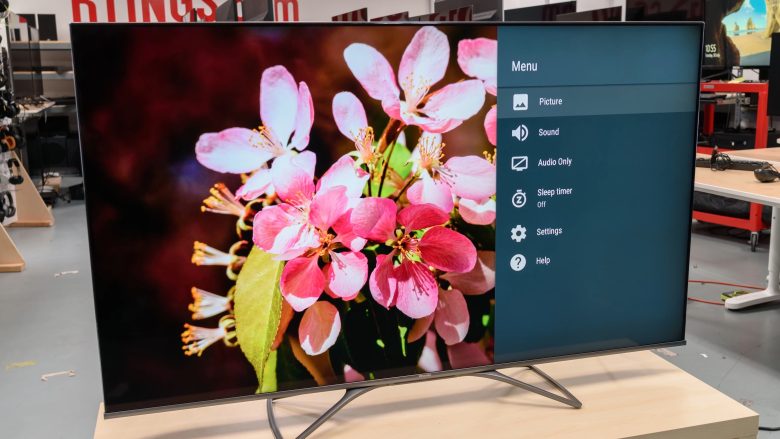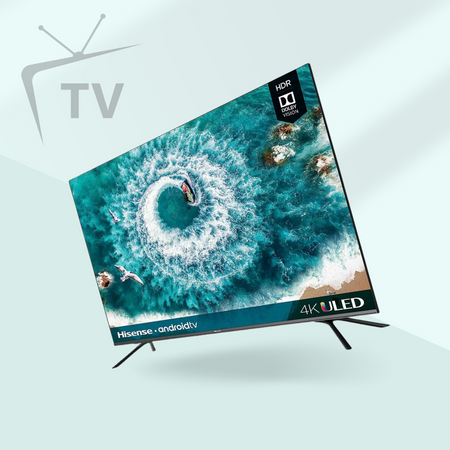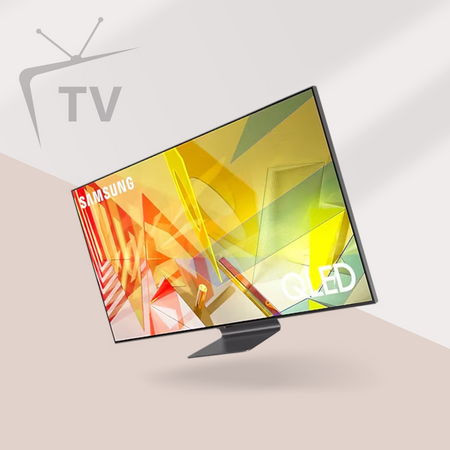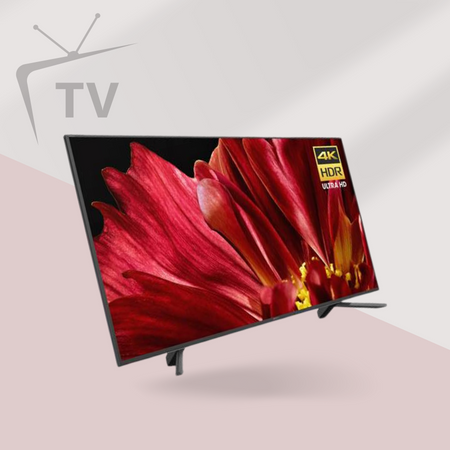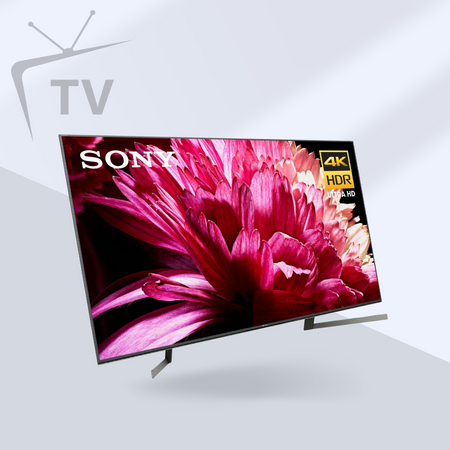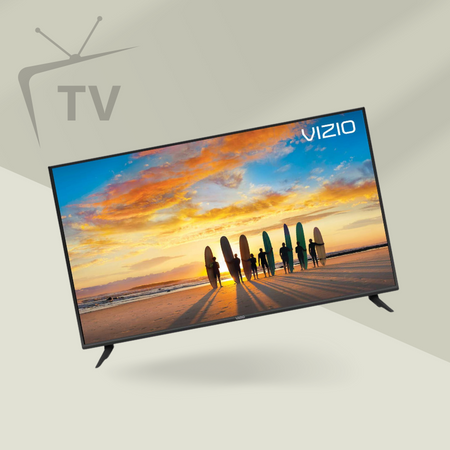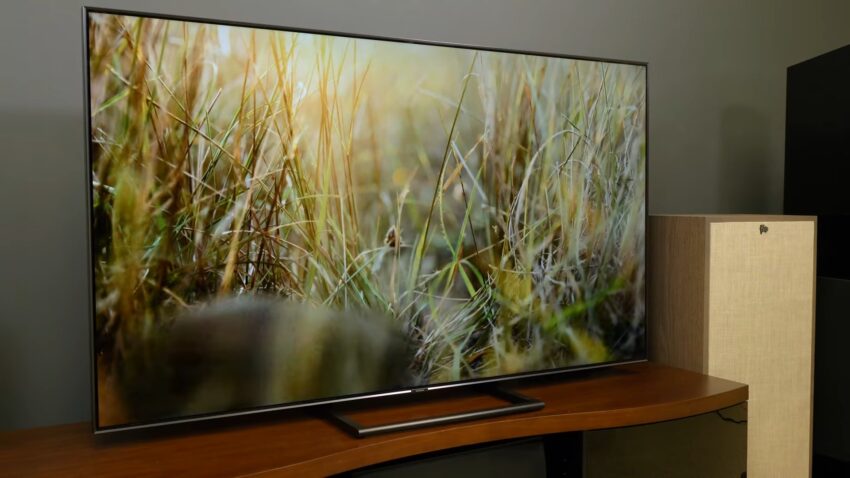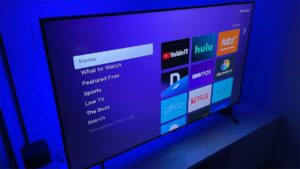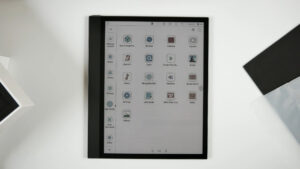The television market is dominated by LED TVs. Every year manufacturers produce a wide number of models with various features. Their biggest benefit is their brightness, which helps them to get almost twice as bright as OLEDs, and the fact they are not susceptible to burn-in.
Our recommendations for the best LED TVs you can buy in 2024 are below. See also our best TV recommendations, the best 4k TVs.
Review of the Top LED TVs
1. Best LED TV: Samsung Q80/Q80R QLED
Available on Amazon
The best overall LED TV we’ve reviewed so far is the Samsung Q80/Q80R QLED. This TV’s performance is low when compared to the higher-end Samsung Q90/Q90R QLED, it’s considerably cheaper and the differences between the two actually don’t make it worth the drop in prices for most people.
This is an outstanding TV for all needs and it has a really quality and very well-constructed style which should look good in any setup.
Due to its very fine contrast and local dimming, this TV shows relatively deep and rich blacks. It can get very light, making it a great choice for well-lit rooms and a great TV for viewing HDR content paired with its wide color gamut.
It has a very fast response time which ensures you shouldn’t see too much of a blurry path behind fast-moving objects and it even has a decently good viewing angle for a VA panel TV. It also has an incredibly low input latency, a simple Auto Small Latency Mode, and facilitates nearly tear-free gameplay in FreeSync.
Looking to invest in a high-end 4K TV? Check out the article on upgrading your viewing experience, which features a detailed review of a top-performing model available on a trusted website.
2. Vizio P Series Quantum X
Available on Amazon
If you want an excellent LED TV but want to pay much less, go to Quantum X 2019 for the Vizio P Series. This doesn’t have almost as large viewing angles as the Samsung Q80/Q80R QLED and removes modern gaming features like FreeSync, but it’s the best TV we’ve reviewed so far and it’s accessible for far cheaper.
HDR material looks amazing due to its extremely bright screen and outstandingly large color gamut, which should pop the way the creator intended. It still has much better motion handling than the Samsung, and when viewing sports there will be few to no visible blurring in motion.
If you play a lot of games or need wider viewing angles, go for the Samsung, but if you want to pay a little less but still get a completely excellent HDR quality Screen, get the Vizio.
3. Best LED TV For Color Accuracy: Sony X900F
Available on Amazon
The Sony X900F is the best LED TV for color accuracy we’ve reviewed so far, if you want the most accurate picture. This TV provides excellent picture quality, an impressive contrast ratio, a decent full variety of local dimming technology, and high peak brightness. It has excellent precision, one of the best LED TV for color accuracy we’ve measured so far, and has a great wide range of colors, which is essential for a successful HDR experience.
Thanks to the outstanding response time, an almost flicker-free backlight and a flexible motion interpolation feature, this TV has excellent motion handling. It also has an optional black frame insertion feature, but you might see visible duplications while playing 60Hz video, as it can’t flicker at 60Hz.
The image degrades just like most VA panel TVs when presented from the edge, so you should be sitting directly in front to enjoy the best frame.
In the article featuring top-rated LED TVs for upgrading your viewing experience, a thorough review of a highly recommended 4K smart TV can be found on a reputable website.
4. Samsung Q70/Q70R QLED- Best LED TV for Gaming
Available on Amazon
If you find the Sony X900F’s gaming output limited due to the lack of external game features, then get the Samsung Q70/Q70R. You won’t get the Sony’s reflex handling or pre-calibration color accuracy, but the Samsung is without a doubt an outstanding LED TV overall.
This provides a great quality picture with deep blacks and can get bright enough to fight glare in almost every space. It has a very low input lag, and it’s filled with game apps such as support for the FreeSync variable refresh rate for almost tear-free gameplay with an Xbox One or a compatible video card device.
If the most important criteria for your decision are color accuracy and darkroom performance, go with the best color accuracy LED: The Sony. However, Samsung is a great choice when you care about advanced gaming apps without much compromise in the quality of the pictures.
5. Best LED TV for Budget: Hisense H9F
Available on Amazon
The Hisense H9F is the best budget LED TV we’ve reviewed for those who believe the Sony X900F is too costly. It is a TV which in most uses delivers very good performance. Thanks to the high contrast ratio and a full array of local dimming help it shows deep blacks in a dark room.
It has a great color gamut and can display HDR content with vivid color and highlights that pop.
Unfortunately, when presented from the side, the picture loses accuracy, but this is normal in most VA panel TVs. Due to the fast response time and the optional black frame inserting feature, motion handling is outstanding on the upside, and it has an excellent low input lag, ideal for gaming or use as a PC monitor.
6. Hisense H8F
Available on Amazon
When you choose an even better option to the Hisense H9F, have a look at its lowe model, the Hisense H8F. You won’t get the other Hisense’s crisp motion, although HDR’s peak brightness isn’t of the same high level. This is a great LED TV for the price on the upside and will keep you happy with its results no matter how useful it is.
Overall, the Hisense H9F is a better option to buy if you care for motion blur and want the crisper image; otherwise, the H8F will keep you happy and will save you some money.
For those on a budget, a reliable and affordable 4K TV option is highlighted in the article on upgrading your viewing experience, with an in-depth review available on a respected website.
7. Samsung Q90T
Available on Amazon
The Samsung Q90T is an outstanding 4k LED TV with outstanding picture quality. It has a strong native contrast ratio, fantastic local support for dimming, and outstanding black uniformity to offer deep blacks in a dark room. The TV can get very bright in both SDR and HDR, and has a broad range of colors that allows it to offer HDR content full of bright colors and highlights that display.
The viewing angles are good due to the’ Ultra Viewing Angle ‘ technology, although the TV has a VA screen. The handling of motions is outstanding and thanks to the very quick response time the image is crisp. The Q90T allows tear-free gameplay with FreeSync and has a very low input latency that renders it sensitive.
8. Sony Master Series Z9F
The Sony Master Series Z9F is a best LED TV that delivers deep, dark colors and high-picture quality with balanced saturation and color contrast. The new X- wide-angle system present in the Sony Master Series provides wider viewing angles that are present in VA panels.
It has an outstanding HDMI system featured with low input lag and supports HDMI 2.0 – complete bandwidth for all four HDMI interfaces. The Android 8.0 smart device is much faster than the previous Sony models.
Due to its dedicated center screen, this 3.1 configuration does a great job of clearly reproducing dialog which ensures you should have no problem hearing speech about background music and sound effects.
It has a decent bass response thanks to its dedicated wireless subwoofer, making it a fine choice for movies too. Unfortunately, while this soundbar supports Atmos, its lack of satellites or upward-firing speakers means the soundstage isn’t very open, and all objects sound as if they’re coming from in front of you.
9. Sony X950 G
Available on Amazon
The Sony X950 G is the best LED tv with great quality images. Thanks to its strong native contrast ratio and a full array of local dimming help, it can view deep blacks in a dark room. It can get very bright and offers great HDR production filled with clear, vibrant highlights.
It has excellent motion handling, due to an almost instant response time that makes the image look crisp and leaves items with very little blur trail. The input lag very low makes it an excellent choice for gamers searching for a very responsive television.
Unfortunately, just like most VA panels, it has narrow viewing angles and those seated on the side will not experience the same great picture quality.
One of the top-rated televisions featured in the article on upgrading your viewing experience has a comprehensive review available on a trusted website.
10. Vizio V Series
Available on Amazon
The 2019 Vizio V Series is an entry-level budget 4k LED TV with good picture quality. It has a high native contrast ratio that provides deep blacks but lacks a local dimming function to enhance performance in dark rooms. In SDR the television can become decently light, but not bright enough in HDR. It has no wide color gamut and can not produce an HDR picture that shines with saturated colors and highlights.
Motion on the Vizio V Series looks smooth but it has a slightly long blur trail for fast-moving content. Unfortunately, the screen lacks any advanced features that allow the action to look crisper. It has a low input lag great for casual gaming.
Our suggestions above are what we think are best LED TVs available in the market. These are the best LED TV to buy in every price range for you. We have analyzed the features and functions of each product and reviewed our best for the buyers.
How to Choose the Best LED TV in 2024
When looking for the best LED TV, there are numerous factors to consider. This buying guide will help you understand the essential aspects to look for when making your decision.
- Screen size: The size of your TV should be determined by your room size and how far you’ll be sitting from the screen. Generally, larger screens provide a more immersive viewing experience, but they also take up more space. Consider your available space and viewing distance before deciding on the screen size.
- Resolution: Resolution refers to the number of pixels on the screen. Higher resolutions, such as 4K (3840×2160 pixels), offer better picture quality than lower resolutions, like 1080p (1920×1080 pixels). If you want the best image quality, opt for a 4K TV.
- HDR: High Dynamic Range (HDR) enhances the color and contrast in images, making them more vibrant and lifelike. If you’re interested in watching HDR content, look for a TV that supports HDR10 or Dolby Vision.
- Refresh rate: The refresh rate measures how many times the screen updates per second, measured in hertz (Hz). A higher refresh rate, like 120Hz, can provide smoother motion for fast-paced content such as sports and gaming. However, 60Hz is usually sufficient for most viewers.
- Smart features: Most LED TVs now come with built-in smart features, allowing you to stream content from various apps, like Netflix, Hulu, and YouTube. Consider the available apps and how user-friendly the interface is when choosing a smart TV.
- Input lag: If you’re a gamer, input lag is an essential factor to consider. Low input lag ensures that there’s minimal delay between your input (like pressing a button on your controller) and the corresponding action on the screen.
- Viewing angle: The viewing angle refers to how far off-center you can sit before the picture quality starts to degrade. If you have a wide seating arrangement or plan on watching TV with large groups, look for a TV with wide viewing angles.
- Connectivity: Consider the number and type of ports available on the TV, such as HDMI, USB, and audio output. Ensure the TV has enough HDMI ports to connect all your devices, like gaming consoles, Blu-ray players, and streaming devices.
FAQs
What is the difference between LED and OLED TVs?
LED TVs utilize a backlight behind an LCD panel to produce an image, while OLED TVs use organic compounds that emit light when an electric current is applied. The main differences between the two are in terms of contrast ratio, black levels, and viewing angles. OLED TVs typically offer better contrast ratios, deeper blacks, and wider viewing angles compared to LED TVs. However, LED TVs can achieve higher brightness levels, which can be an advantage in well-lit rooms.
How do I choose the right screen size for my room?
When selecting the screen size for your TV, consider the viewing distance and the size of the room. A general rule of thumb is to multiply the screen size (in inches) by 1.5 to determine the minimum viewing distance (in feet). For example, for a 55-inch TV, the minimum viewing distance should be around 7.5 feet. However, personal preferences may also play a role, so it’s essential to test different screen sizes and distances to find the most comfortable setup for your needs.
What is HDR, and why is it important?
HDR (High Dynamic Range) refers to a technology that enhances the contrast and color range in images, resulting in more vibrant and lifelike visuals. HDR content typically has brighter highlights, more detailed shadows, and a wider color gamut compared to standard dynamic range (SDR) content. To take full advantage of HDR, your TV must support HDR formats such as HDR10, Dolby Vision, or HLG.
What is the difference between 4K and 1080p resolution?
4K resolution (also known as Ultra HD) has a resolution of 3840 x 2160 pixels, which is four times the resolution of 1080p (1920 x 1080 pixels). This increased resolution results in sharper images and more detail, especially when viewed on larger screens. However, to fully appreciate the benefits of 4K, you’ll need to watch 4K content and have a TV that supports this resolution.
How important is the refresh rate for a TV?
The refresh rate, measured in hertz (Hz), indicates the number of times per second that the screen updates the image. A higher refresh rate can result in smoother motion and reduced motion blur, especially in fast-moving content like sports and action movies. Most TVs have a native refresh rate of 60Hz, while some higher-end models offer 120Hz or even 240Hz. However, the difference between 60Hz and higher refresh rates may not be noticeable for everyone, so it’s essential to consider your viewing preferences and the types of content you watch most frequently.
Related Posts:
- 12 Best Roku Smart LED TVs 2024 - Excellent Viewing…
- Samsung MU6290 Smart TV 2024 Review - Upgrade Your…
- Sony Master Series A9F OLED TV 2024 - Elevate Your…
- LG B9 OLED TV 2024 - Elevate Your Viewing Experience…
- Hisense H8F TV 2024 Review - Elevate Your Viewing…
- Sony X720E HDR TV 2024 Review - Elevate Your Viewing…


